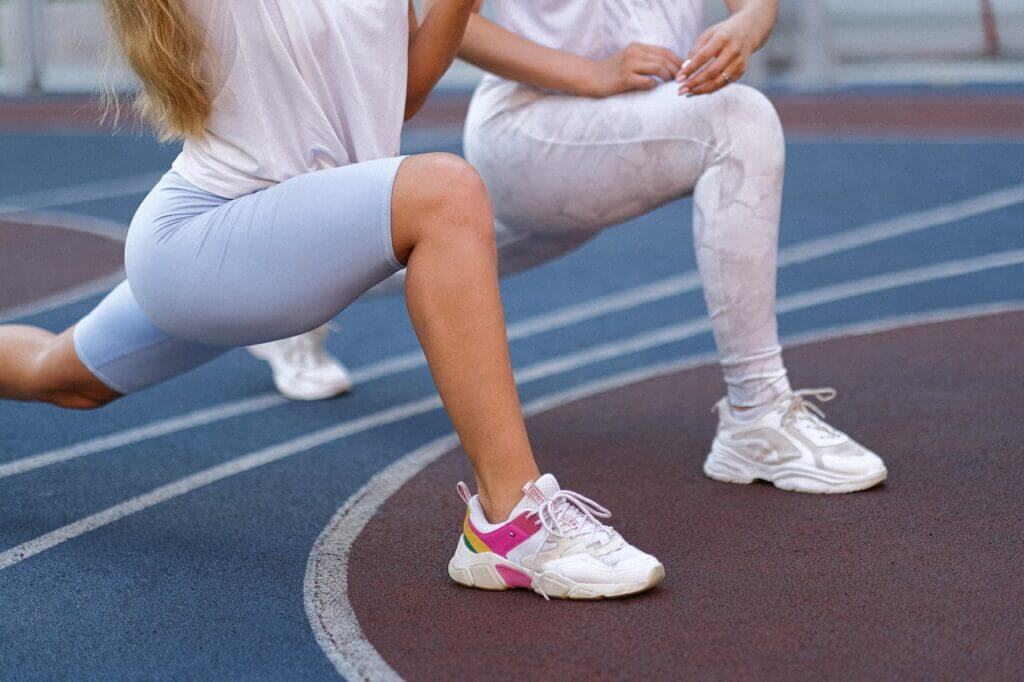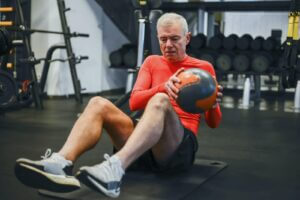Are you ready to take your running game to the next level? Whether you’re a seasoned marathoner or just starting out on your jogging journey, one thing is certain: warm-up stretches are the secret sauce to unlocking your full potential as a runner. Picture this: you’re lacing up your running shoes, feeling the excitement building up as you prepare to hit the pavement. But before you take off, there’s an essential ritual that can make all the difference in your performance and overall running experience.
It’s time to dive into the world of warm-up stretches for runners, where a few minutes of preparation can lead to miles of success. In this blog post, we’ll unveil five essential warm-up stretches that will not only boost your performance but also help prevent those nagging injuries that can derail your training. So, let’s limber up, loosen those muscles, and get ready to elevate your running journey to new heights!
Table of Contents
Stretch 1: Dynamic Leg Swings
When it comes to warming up before a run, dynamic leg swings are an absolute game-changer. These stretches are not only effective but also quite enjoyable to perform. They help to loosen up your leg muscles, increase your range of motion, and prepare your body for the demands of running.
To do dynamic leg swings, follow these simple steps
- Find a clear space where you have enough room to swing your legs freely.
- Stand tall with your feet shoulder-width apart.
- Place your hands on a nearby support, such as a wall or railing, for balance.
- Start with your right leg. Swing it forward and backward in a controlled manner, like a pendulum. Aim for a comfortable range of motion.
- After several swings, switch to your left leg and repeat the same motion.
- Continue swinging your legs back and forth for about 10-15 swings on each side.
Benefits for runners
Dynamic leg swings offer several benefits for runners. Firstly, they increase blood flow and warm up the muscles, reducing the risk of injuries. Secondly, these swings help to improve flexibility and mobility, especially in the hip and hamstring areas. This improved range of motion can enhance your stride length and running efficiency.
Remember, it’s essential to perform dynamic leg swings in a controlled manner and avoid any jerky movements. If you feel any discomfort or pain, make sure to ease off or modify the motion accordingly. Adjust the range of motion based on your current flexibility level, gradually increasing it over time.
By incorporating dynamic leg swings into your warm-up routine, you’re setting yourself up for a successful and enjoyable run. Give them a try and feel the difference in your performance and overall running experience. Ready to move on to the next stretch? Let’s dive into the hip flexor stretch, another crucial exercise for runners.
Stretch 2: Hip Flexor Stretch
The hip flexor stretch is a fantastic warm-up exercise for runners that specifically targets the muscles in the front of your hips and thighs. By focusing on your hip flexors, you can improve your range of motion, increase flexibility, and enhance your overall running performance. So, let’s dive into this essential stretch and learn how to do it properly.
Description of the exercise
To begin, find a clear space where you can comfortably stand. Take a step forward with your left leg, ensuring that your knee is directly above your ankle. Keep your right leg extended behind you with your toes resting on the ground. This position will form a lunge-like stance. You’re now ready to perform the hip flexor stretch!
Benefits for runners
Stretching your hip flexors has several advantages for runners. It helps to alleviate any tightness or tension in the hips caused by prolonged sitting or running, which can hinder your stride and overall running efficiency. By regularly incorporating this stretch into your warm-up routine, you’ll enhance your hip flexibility, stride length, and overall running mechanics.
Step-by-step instructions for performing the stretch
- Assume the starting position by standing with your feet hip-width apart.
- Take a step forward with your left leg, creating a comfortable distance between your feet.
- Lower your body into a lunge position, ensuring that your left knee is directly above your ankle.
- Keep your right leg extended behind you with your toes touching the ground.
- Engage your core muscles and maintain an upright posture.
- Slowly shift your weight forward, allowing a gentle stretch in the front of your right hip.
- Hold this position for about 20 to 30 seconds while focusing on deep, controlled breathing.
- Release the stretch and return to the starting position.
- Repeat the stretch on the other side by stepping forward with your right leg.
Remember, it’s crucial to perform this stretch with proper form and avoid any excessive leaning or overarching of the lower back. Take your time and ease into the stretch gradually, allowing your muscles to relax and lengthen.
By regularly including the hip flexor stretch in your warm-up routine, you’ll not only improve your running performance but also reduce the risk of potential injuries caused by tight hips. So, let’s give our hip flexors the attention they deserve and take our running to the next level!
Stretch 3: Calf Stretch
When it comes to running, strong and flexible calves are crucial for optimal performance and injury prevention. The calf muscles play a significant role in absorbing the impact of each stride and propelling you forward. That’s why including a calf stretch in your warm-up routine is essential. Let’s dive into the details of this rejuvenating stretch.
Description of the Exercise
The calf stretch primarily targets the two major muscles in your calf: the gastrocnemius and soleus muscles. This stretch can be done in various ways, but we will focus on the classic standing calf stretch.
Benefits for Runners
Performing a calf stretch before your run offers several benefits that can greatly impact your performance. Here are a few key advantages:
- Improved Flexibility: Regularly stretching your calf muscles increases their flexibility, allowing for a longer and more efficient stride while running.
- Reduced Risk of Injury: Tight calf muscles can contribute to common running injuries like calf strains or Achilles tendonitis. Stretching helps to alleviate muscle tension, minimizing the risk of these injuries.
Step-by-Step Instructions
To perform a standing calf stretch, follow these simple steps:
- Find a sturdy wall or a tree to support yourself.
- Stand arm’s length away from the wall, placing one foot slightly in front of the other.
- Keep your front leg bent while extending your back leg straight behind you, ensuring your heel remains on the ground.
- Lean forward gently, maintaining a straight back, until you feel a stretch in your calf muscle.
- Hold the stretch for about 20-30 seconds, focusing on deep and relaxed breathing.
- Repeat the stretch with the other leg.
Remember, it’s essential to perform this stretch on both legs to maintain balance and symmetry.
Incorporate this calf stretch into your warm-up routine before every run, and over time, you’ll notice improved flexibility, increased comfort while running, and reduced risk of calf-related injuries. It’s a small investment of time that can make a big difference in your overall performance.
Stay tuned for the next section, where we’ll explore the benefits of the glute bridge, another fantastic warm-up stretch for runners.
Stretch 4: Glute Bridge
The glute bridge is an excellent warm-up stretch that specifically targets the gluteal muscles, also known as the buttocks. These muscles play a crucial role in running by providing stability and power to your stride. Adding the glute bridge to your warm-up routine can help activate and engage these muscles, setting the stage for a strong and efficient run.
To perform the glute bridge, follow these simple steps
- Lie on your back with your knees bent and your feet flat on the ground, hip-width apart.
- Keep your arms relaxed by your sides, with your palms facing down.
- Gently contract your abdominal muscles to stabilize your core.
- Press through your heels, engaging your glutes and hamstrings, and lift your hips off the ground until your body forms a straight line from your shoulders to your knees.
- Hold this position for a few seconds, focusing on squeezing your glutes.
- Slowly lower your hips back down to the starting position.
As you perform the glute bridge, pay attention to maintaining proper form. Avoid arching your lower back or pushing your hips too high, as this can put unnecessary strain on your spine. Aim for a smooth and controlled movement, focusing on activating your glutes throughout the exercise.
Incorporating the glute bridge into your warm-up routine offers several benefits for runners. It helps activate and strengthen the gluteal muscles, which can improve your running form, enhance stability, and prevent muscle imbalances. Strong glutes also contribute to better propulsion and increased power during your runs, helping you achieve better overall performance.
Remember, warming up your body before a run is essential to prepare your muscles, joints, and cardiovascular system for the upcoming physical activity. The glute bridge is a valuable addition to your warm-up routine, specifically targeting an important muscle group for runners.
So, before you hit the pavement for your next run, take a few minutes to include the glute bridge in your warm-up routine. Your glutes will thank you, and you’ll be on your way to a stronger and more enjoyable running experience.
Stretch 5: Standing Quad Stretch
Now, let’s focus on another fantastic warm-up stretch that can do wonders for your running performance: the standing quad stretch. This stretch targets your quadriceps, the group of muscles on the front of your thighs that play a vital role in running.
To perform the standing quad stretch
- Find a clear space and stand tall with your feet hip-width apart.
- Use your right hand to grab your right ankle or foot, bringing your heel towards your glutes. Maintain a straight posture throughout.
- Engage your core to maintain balance and stability.
- If needed, gently press your hips slightly forward to deepen the stretch.
- Hold the stretch for about 20-30 seconds, feeling the gentle pull in your quadriceps.
- Release the stretch and repeat on the other leg, following the same steps.
Stretching your quadriceps before running is essential for several reasons. Firstly, it helps improve flexibility and range of motion in your hip joints, allowing for a more efficient running stride. Secondly, it helps activate and engage the quadriceps, which can enhance muscle performance and reduce the risk of injury. Lastly, this stretch can alleviate any tightness or tension in your quads, helping you feel more comfortable during your run.
Remember, while performing the standing quad stretch, it’s important to listen to your body and never force the stretch beyond your comfort level. Gradually increase the intensity of the stretch over time as your muscles become more flexible.
Incorporating the standing quad stretch into your warm-up routine will contribute to a well-rounded preparation for your run. By paying attention to your quadriceps and giving them some extra love before hitting the pavement, you’ll be setting yourself up for a more enjoyable and productive running experience.
Stay tuned for the next section, where we’ll share some valuable tips to create an effective warm-up routine that complements these essential stretches.
Tips for an Effective Warm-Up Routine

To ensure that your warm-up stretches are effective and help you maximize your running performance, here are some valuable tips to keep in mind:
1. Duration and Holding Time
It’s important to allocate enough time for your warm-up routine before hitting the pavement. Aim for a warm-up session of about 10-15 minutes. For each stretch, hold the position for approximately 20-30 seconds. This duration allows your muscles to gradually loosen up and prepares them for the upcoming run.
2. Repetitions
Generally, performing 2-3 repetitions of each stretch is sufficient. However, pay attention to your body’s response and adjust accordingly. If you feel like you need a little extra stretching, don’t hesitate to add an extra repetition or two.
3. Listen to Your Body
Every runner is unique, and your warm-up routine should be tailored to your individual needs. While these essential stretches work well for most people, it’s crucial to listen to your body and adapt the routine to address any specific areas of tightness or discomfort you may have. Don’t force any stretch that causes pain; instead, modify it or consult a professional if needed.
4. Additional Warm-Up Exercises
While the focus of this blog post is on warm-up stretches, it’s worth mentioning that incorporating other exercises into your routine can be beneficial. Activities like light jogging, brisk walking, or even jumping jacks can help increase your heart rate and warm up your entire body. Consider adding some of these dynamic movements before diving into your stretching routine.
Remember, the goal of your warm-up routine is to gradually prepare your muscles and joints for the demands of running. By following these tips, you’ll be well on your way to an effective warm-up session that sets the stage for an enjoyable and successful run.
Now that you have a solid understanding of the essential warm-up stretches and some valuable tips, let’s move on to the conclusion where we’ll recap the importance of incorporating these stretches into your running routine.
Conclusion
Incorporating these 5 essential warm-up stretches into your running routine can make a world of difference in your performance. By taking a few minutes to properly prepare your muscles and joints, you’ll unlock your full running potential and reduce the risk of injuries.
So, don’t skip the warm-up! Boost your performance, reach new milestones, and enjoy every stride on your running journey. Your body will thank you, and you’ll conquer the road ahead with confidence. Happy running!


